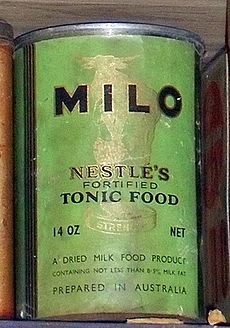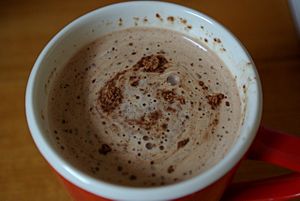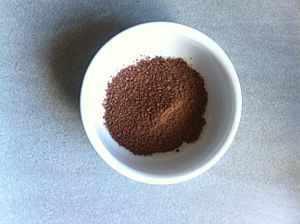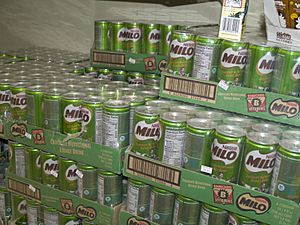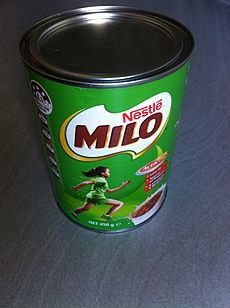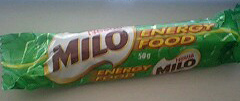Milo (drink) facts for kids
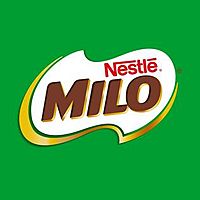
MILO's logo
|
|
| Type | Malted dairy milk |
|---|---|
| Owner | Nestlé |
| Country | Australia/New Zealand |
| Introduced | 1934 |
| Markets | Worldwide; most notably the regions of Oceania, South America, South-east Asia and certain parts of Africa |
| Tagline | MILO Everyday! |
Milo (stylized as MILO) is chocolate and malt powder that is mixed with hot water and milk to produce a beverage popular mainly in Oceania, South America, South-east Asia and certain parts of Africa. Produced by Nestlé, Milo was originally developed by Thomas Mayne in Sydney, Australia in 1934. It is marketed and sold in many countries.
Most commonly sold as a powder in a green tin, often depicting various sporting activities, Milo is available as a premixed beverage in some countries, and has been subsequently developed into a snack bar and breakfast cereal. Its composition and taste differ in some countries.
Milo maintains significant popularity in a diverse range of territories, including Malaysia, Philippines, Indonesia, Colombia, Peru and Central and West Africa.
Contents
Manufacture
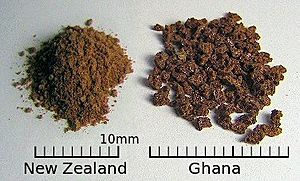
Milo is manufactured by evaporating the water content from a thick syrup at reduced pressure. The thick opaque syrup is obtained from malted wheat or barley that is sourced from companies that produce these raw products. In 2016, Nestle Philippines stated that it will begin to produce Milo using its "protomalt" formulation sometime in 2017. The protomalt is composed of carbohydrates derived from barley and cassava.
History
In 1934, Australian industrial chemist and inventor Thomas Mayne developed Milo and launched it at the Sydney Royal Easter Show. Milo began production at the plant located in Smithtown, near Kempsey on the North Coast of New South Wales. The name was derived from the famous ancient athlete Milo of Croton, after his legendary strength.
Consumption
Milo is sometimes sprinkled on ice cream or breakfast cereals. Milo is often the favoured beverage for the Tim Tam Slam..
Milo manufactured outside Australia is customised for local methods of preparation. In Malaysia and Singapore as well as Brunei and some other parts of Asia, Milo with ice added is known as "Milo Ice" (alternatively, "ping" or "peng", meaning ice in Cantonese and Hokkien respectively). Iced milo is even available at fast food restaurants such as KFC and McDonald's. Milo is also served locally in kopitiams and mamak stalls in versions such as "Milo Dinosaur" (a cup of Milo with an extra spoonful of undissolved Milo powder added on top of it), "Milo Godzilla" (a cup of Milo with ice cream and/or topped with whipped cream) and "Neslo" (combined with Nescafé powdered coffee). The Milo powder is also usually used in the making of Batik cake. In Hong Kong, Milo is served in Cha chaan teng.
Milo is also a famous beverage in Indian Muslim stalls, or fondly known as Mamak stalls in Malaysia. It is also sometimes used as an alternative to jam and spread on bread or also as an ingredient in Roti Canai, and is usually called "Roti Milo".
Marketing
In Australia and most other countries, the packaging is green and depicts people playing various sports on the tin. A higher malt content form also existed in Australia and was marketed in a brown coloured tin which was usually only available in the 375g size. As of May 2015, this form is no longer manufactured. An organisation called MILO in2CRICKET, which operates in most areas by volunteers, teaches girls and boys the skills of the game.
Milo's commercials and taglines are "Go and go and go with Milo". A recent Australian commercial incorporating this slogan depicts four generations of women on a skipping rope singing "and my mum gave me Milo to go and go and go." The tag "I need my Milo Today" is also used. The packaging of tins of Milo in Malaysia and Singapore are also green and also have people playing sports on the tins, giving it the affectionate name of "Tak Kiu", which is Hokkien Chinese for football. In Colombia, Milo is closely tied to football, and the slogan several generations have sung is Milo te da energía, la meta la pones tú ("Milo gives you the energy, you set the goal").
Milo is very popular in Malaysia and Singapore, where the brand name is synonymous with chocolate flavoured drinks: Milo has a 90% market share in Malaysia (not the often quoted 90% worldwide share of Milo consumption), and Malaysians were said to be the world's largest consumers of Milo. This is because Milo was once used as a nutrient supplement when it was first introduced in the country, and has thus gained a reputation as a 'must have' drink for the old and the younger generations. Milo manufactured in Malaysia is made to dissolve well in hot water to produce a smooth hot chocolate drink, or with ice added for a cold drink. "Milo Vans" were often associated with sports days in these two countries, during which primary school pupils would queue up to collect their cups of Milo drinks using coupons.
In Peru, during the 1970s military dictatorship, Milo labels displayed Peruvian motifs, such as photos and pictures of Peruvian towns, history, crops, fruits, animals, plants, as an educational aid. After 1980, when the military left power, sports predominated on the labels.
Nestlé has now introduced a Canadian version of Milo. It dissolves rapidly like Nesquik, probably due to market expectations, but still retains the malt flavour. It is also sweeter than other varieties. This Milo as the brand has been in Eastern Canada since the late 1970s with the influx of people from previous British colonial territories such as the Caribbean and Hong Kong, and India. It was available in most small ethnic grocery stores, especially Caribbean food stores. It has recently been selling at larger chains to beef up their share in the ethnic market in Canada, and is now available in places like Superstore, Extra Foods and London Drugs. Some East Asian supermarkets (such as T&T Supermarket in Edmonton, Vancouver, Toronto, and Calgary) will carry the version imported from China or Hong Kong, China.
Aside from the International section of specific grocery stores and certain Asian grocery stores, Nestlé does not market Milo in the United States. In 2017 the Colombian manufactured Milo has started appearing on shelves in supermarkets in the United States such as Walmart (Alongside Hispanic sections), and King Soopers (Denver CO).
It can also be found in the United Kingdom in some Sainsbury's and Tesco supermarkets, which import it from Kenya and South Africa. Asian food specialists, such as Mini Siam Oriental Foods and Hoo Hing also stock it. A similar product called Ovaltine is most popular with UK consumers.
In Ireland, it can be found in many Asian or African stores. Typically they will stock Kenyan or Filipino Milo.
In China, it is commonly sold in western supermarkets, but also smaller convenience stores. Usually packaged in a 240gram flexible foil pouch, single drink packets can also be purchased. The Milo itself contains more milk solids than the Australian Milo, and so it is not necessary to add milk before consumption.
In the past, it was available in Portugal and Brazil. Nestlé Brazil discontinued production of Milo in Brazil, to focus on the much-popular domestic brands Nescau and Nesquik. The Chilean version of Milo is still in production and is identical in taste and texture to the one that was once produced in Brazil.
In May 2013, and after more than 20 years out of the Portuguese market, Nestlé reintroduced the brand aiming at the high-end market.
Nutritional information
Milo contains 1,680 kJ (402 calories) in every 100 g of the powder, mostly from carbohydrates. Carbohydrates can be used for energy by the body, which is the basis of Milo being marketed as an energy drink. Most of the carbohydrate content is sugar. The New Zealand version of Milo is 46 per cent sugar.
Milo dissolved in water has a Glycemic Index (GI) of 55, the same as Coca-Cola. However, milk has a much lower GI of 30 - 33, so mixing a very small amount of Milo into a mug of milk yields an overall GI closer to 33, and mixing a large amount of Milo into a mug of milk will give a GI closer to 55.
The Milo website states that the drink is high in calcium, iron and the vitamins B1, B2, B6, B12. Milo is advertised as containing "Actigen-E", but this is just Nestlé's trademarked name for the vitamins in the Milo recipe.
Milo contains some theobromine, a xanthine alkaloid similar to caffeine which is present in the cocoa used in the product.
Derivative products
Milo is available as a snack in cube form, in Nigeria, Ghana and Dubai.
In Australia, a new version of Milo called Milo B-Smart was released in 2008 (the original and malt Milo varieties remain); which is of a finer texture and has added B vitamins and iodine. It has a different taste from the original Milo formula and is marketed as a health food for children.
Images for kids
See also
 In Spanish: Milo (bebida) para niños
In Spanish: Milo (bebida) para niños


